In this amazing world, to me every creature is fascinating and beautiful in its own way. Nature has a way of showing off the remarkable, and it’s like an addictive thrill for me to find and watch nature in action — the way a tiny jumping spider stalks the much larger ant, the way a bird tilts its head to watch for predators while it eats, the different pitches of the mating sounds of the male toads croaking by the pond. I’ve been studying nature my whole life, and it never ceases to amaze me.
When nature is left to its own devices, a balance of predator and prey is the expected result, and the natural dynamics of an ecosystem in their own right are fascinating. Even now I feel the shock of climbing a ladder years ago to peer at new baby birds in a nest, only to discover a snake actively swallowing the last baby bird there. But it was nature in action, and while my heart was broken, I used it as an opportunity to teach my young children that the snake has a right to live as much as the little birds, and while we might not like what happened, it’s nature. And then we talked about the hinged jaws of a snake, and all was good.
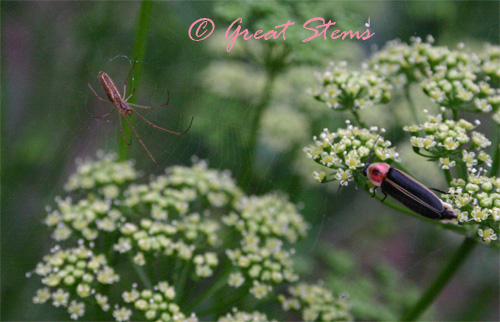 So what makes a wildlife lover become executioner, a god deciding who shall live and who shall die? How can one be absolutely dedicated to gardening for wildlife and seeking out the fascination that nature inspires, then cross the line to what feels like heartless murder?
So what makes a wildlife lover become executioner, a god deciding who shall live and who shall die? How can one be absolutely dedicated to gardening for wildlife and seeking out the fascination that nature inspires, then cross the line to what feels like heartless murder?
I’ve already crossed the line to actively killing fire ants in my yard. Anyone who has ever been bitten and stung, especially repeatedly, knows why these invasive insects are such a serious danger and problem. For immediate control, we use the boiling water method, but I also use beneficial nematodes and organic bait to help control these aggressive and painfully fierce armies of ants. Not only am I doing this to discourage a rampant problem from growing worse, but I’m a mother protecting her family from danger. So, easy justification.
I also have crossed the line to removal by hand of spotted cucumber beetles, aphids, stink bugs, grasshoppers, and a few others. But now I face a new foe, and a new dilemma. My tomatoes are in danger… from a most beautiful pest.
This is my first year growing tomatoes — Romas, Brandywines, and Tomatillos– and so far so good. The bushes are outgrowing their cages and already need new support.
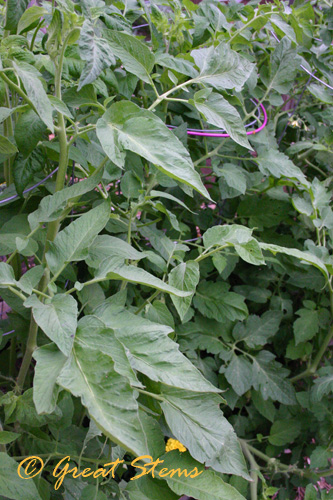 The young Roma tomatoes are plentiful, and the flowers on the Brandywines let me know they aren’t far behind. The tomatillos are younger but well on their way.
The young Roma tomatoes are plentiful, and the flowers on the Brandywines let me know they aren’t far behind. The tomatillos are younger but well on their way.
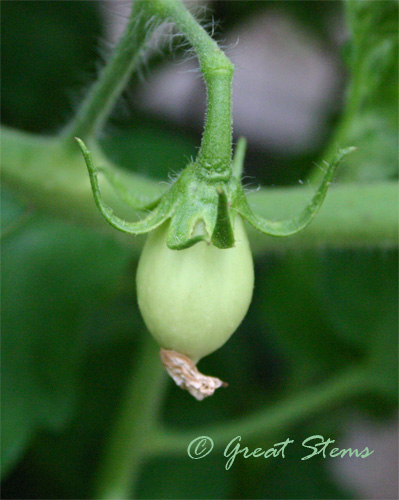 But the other night, a friend came over to share a birthday key lime pie I’d made my husband, and we ventured outside in the dark with flashlight in hand to view my enormous tomato bushes. My friend had been talking about a little green worm he’d found munching on his tomatoes at home, and wouldn’t you know when he reached out to my tomatoes in the dark, he found a “squishy” creature on my tomatoes, too!
But the other night, a friend came over to share a birthday key lime pie I’d made my husband, and we ventured outside in the dark with flashlight in hand to view my enormous tomato bushes. My friend had been talking about a little green worm he’d found munching on his tomatoes at home, and wouldn’t you know when he reached out to my tomatoes in the dark, he found a “squishy” creature on my tomatoes, too!
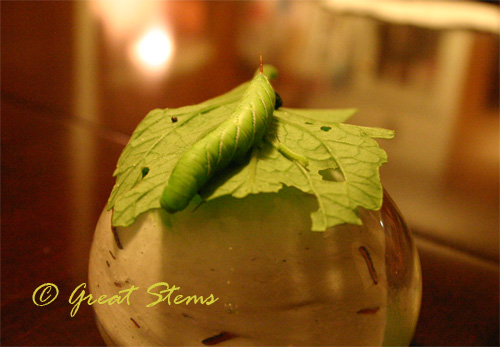
It was a hornworm — specifically a tobacco hornworm, designated by the red horn on its end. We brought it back into the house and watched it munch away on the leaf we’d brought back with it (there were actually two — see the small one there as well?). It became the table centerpiece and primary topic of conversation as we munched on key lime pie and it on its tomato leaf. We watched it munch and poop and munch some more — yes, now you know how far I’ll go to study nature. And we truly admired its beauty –a tobacco hornworm and its counterpart the tomato hornworm are gorgeous as far as caterpillars go, and the large sphinx moths they become are beautiful, too.
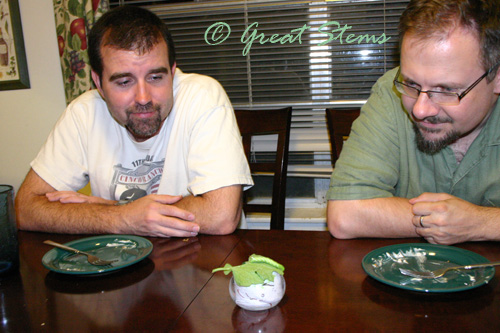
But we also discussed the dilemma I was in. If I let it live and go back to feasting on my tomato plants, its voracious appetite would defoliate my plants in a flash and leave holes in my young tomatoes. But after an evening of studying the little guy, could I just brutally murder this lovely green caterpillar just innocently munching on the leaves its mama left it on? Was this the Last Supper?
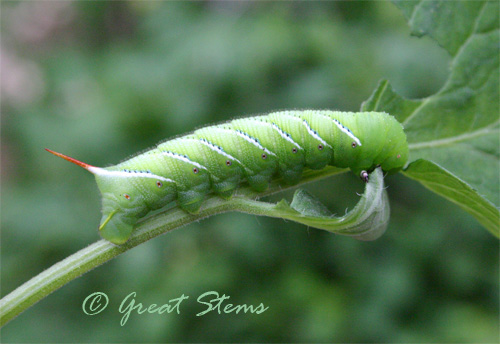 Ultimately I decided not to dwell on the pending demise of this pretty caterpillar. I knew the outcome the moment we’d found it. The fact is, I have an investment in the vegetable garden, and while many plants elsewhere in my yard are chosen for the wildlife that depend on them, my tomatoes are there for my family. Hornworms have a history of being pretty terrible pests, and if I let this one live, more will come to my tomatoes.
Ultimately I decided not to dwell on the pending demise of this pretty caterpillar. I knew the outcome the moment we’d found it. The fact is, I have an investment in the vegetable garden, and while many plants elsewhere in my yard are chosen for the wildlife that depend on them, my tomatoes are there for my family. Hornworms have a history of being pretty terrible pests, and if I let this one live, more will come to my tomatoes.
I did give it a home for the night and a bit of breakfast (the Last Breakfast, as it were) while I looked for its siblings on my tomato plants. I couldn’t find anymore, but I suspect they are just quite adept at blending in. And in the morning daylight, the true beauty of the caterpillar was apparent. Look at how the lines on its body eventually converge to form the horn.
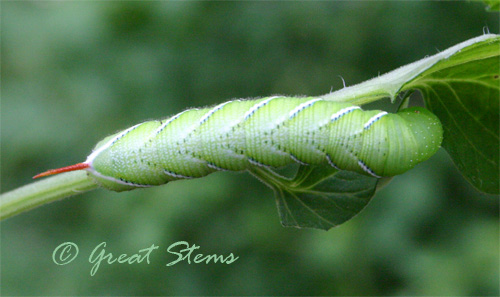 With sadness, this morning the caterpillar will go to the bird feeder tray. I can’t bring myself to do the deed, but perhaps a bird will do the job for me.
With sadness, this morning the caterpillar will go to the bird feeder tray. I can’t bring myself to do the deed, but perhaps a bird will do the job for me.
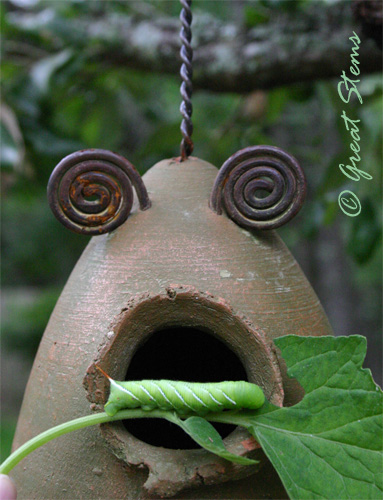 And there is the wildlife lover’s dilemma. I’m having to send that which I admire to its doom, but maybe I can feel good that a bird will be happy. For what it’s worth, little caterpillar, I’m sorry.
And there is the wildlife lover’s dilemma. I’m having to send that which I admire to its doom, but maybe I can feel good that a bird will be happy. For what it’s worth, little caterpillar, I’m sorry.
EDIT:
Umm, yeah. I just went outside to the tomatoes again and found this monster. They get rather fat and a little more intimidating when they’re gigantic and practically bursting with your tomato plants inside them… And talk about the elephant of all caterpillar poop. I’m letting you imagine it rather than sharing a picture, but trust me, HUGE.
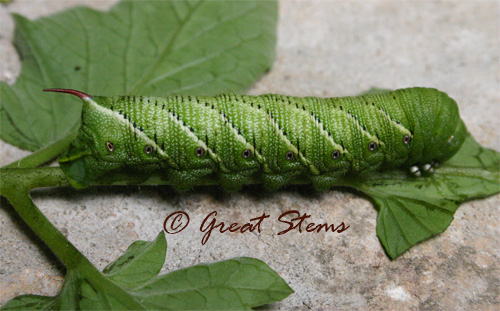
I saw this squirrel at the feeder when I put the caterpillars out. Think she’ll eat them?

My husband’s comment: Maybe the caterpillars will eat the squirrel.
Cool pictures. I totally did not notice the rivet-looking circular spots on the caterpillar’s side when we were messing with it.
I read that you can use a black-light at night to find horn-worms in your plants since the white strips should fluoresce.
BTW, I was very impressed how vigorous your plants looked. My tomato plants are much sparser and the leaves are a bit funky – I wonder whether they might be suffering from curly top disease…
Lovely pictures, especially the birdhouse about to eat up the the hornworm! I found a brown tomato hornworm in my garden late last fall. I had never seen one before.
That snake did what it was supposed to do to survive. You do what you are supposed to do to survive and feed your family. We are a part of the food chain. The picture of sacrifying a worm to birds is great!
Very nice post, Meredith! So far (knock on wood) I haven’t had a hornworm on my tomato plants any year that I’ve planted them…but they are very interesting to look at up close. Your photos are great! I’ve always heard people say things like ‘yuck’, ‘ew’, etc…but I suppose that’s after they get really big and fat! I hope you don’t have too many more to deal with, but at least you can pass them off to the birds for some snacking pleasure;-)
I have the same dilemmas. For what it’s worth, MSS from Zanthan Gardens picks hers off the plants and puts them in the compost bin.
Well, it didn’t take long and the caterpillars were snatched up by a bird or two. Definitely a tasty treat for the birds, and while I feel a little bad for our dinner guest caterpillar in particular, I’m glad to know that other wildlife benefitted from the little green guys’ demise.
I just read this post yesterday and then this morning I went out to the garden and found a HUGE hornworm feasting on Clerodendrum indicum. Hornworms will feed on most members of the Solanaceae family but Clerodendrum is in the Verbenaceae family so clearly they are not that discriminating when they’ve got the munchies. You may be able to find some other plant in your yard that will appeal to the hornworm and that will be able to withstand a few chewed leaves!
Just had the same hornworm dilemma this morning, and I used your approach (moved him to the birdbath area). All’s fair in love for tomatoes, right?
Was thinking about this post while I was in the garden today. Found a little green looper on my potted Streptocarpus. What wildlife gardeners would like to know, is, which other plant can I offer this caterpillar. A plant that I AM willing to share. Meanwhile Grower Jim has answered for you. I just dump the offending caterpillar somewhere away, to take its chances. Find lunch, or be Lunch.
What a thrilling post. Yes, I would actually like to see the caterpillar poop!
Tomato hornworms – especially covered in parasitic wasp larva are horrible things that cause nightmares for me. I love your fascination with nature. I could have that same patience and fascination, but some insects I just cannot watch for too long. Do you ever have nightmares??!
I’m not sure anything eats the hornworms. I watched the cardinals in my garden they went for the small green caterpillars and leave these alone. I haven’t seen any for ages. They came after the sphinx moths were visiting the columbines but the moths are no longer around. I have no problems taking them off. We won’t even make a dent in their population.
Wendy, no nightmares about nature. It’s too fun to explore and learn about. Any nightmares I do get are none I care to write about!
Jenny, the birds have snatched up the hornworms I’ve been putting in the birdfeeder. Either that or the naughty birdseed-eating squirrel decided to get some caterpillar protein after all. In any case, the hornworms are definitely on the meal plan of something else in my garden, so it’s all good.
My chickens won’t eat them unless I cut them up…they’re too big! I understand your dilemma and worry about having several habitats in one yard. But, hopefully Mother Nature and Father Time are paying attention…we’re only human and doing the best we can. Nice blog, great photos!
Pingback: Not All Hornworms Eat Tomatoes | Great Stems
Meredith, I must be missing my brain today, as I can’t find where to follow your blog. Is threre a button I have missed? Thank you!
Look under “Feed Me, Seymour” in the sidebar, Lea — it’s there!